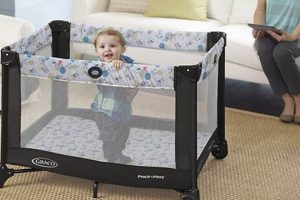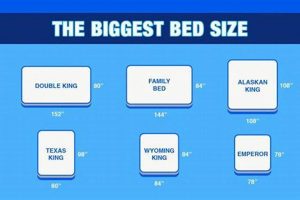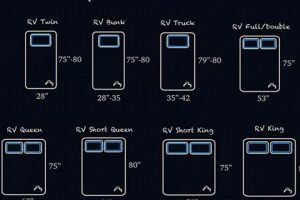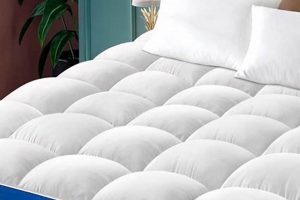A sleeping surface designed for recreational vehicles that approximates the dimensions of a standard queen-sized bed is a common feature in many RV models. Typically measuring around 60 inches wide and 80 inches long, these mattresses often differ from residential versions in terms of thickness and materials used, accounting for space constraints and weight considerations within the RV. These dimensions provide adequate sleeping space for two adults.
The inclusion of a comfortable sleeping arrangement significantly enhances the travel experience, promoting restful sleep during journeys and at campgrounds. Historically, RV mattresses were often thin and unsupportive, but modern advancements in materials and manufacturing have led to improved comfort and durability. This improvement addresses the need for restorative rest, enabling travelers to fully enjoy recreational activities.
Subsequent sections will delve into the specific types of mattresses available for RVs, explore the material compositions that contribute to comfort and longevity, and offer guidance on selecting the appropriate sleeping solution based on individual needs and RV configurations. Considerations will include factoring in the interior space of the RV and any weight limitations.
Essential Considerations for Queen Size RV Mattress Selection
Optimizing the comfort and longevity of an RV sleeping arrangement necessitates careful consideration of several key factors. These tips provide guidance for selecting an appropriate mattress.
Tip 1: Measure Available Space Accurately: Prior to purchasing, precisely measure the dimensions of the designated sleeping area within the RV. Note any obstructions or irregularities that may affect mattress fit. Confirm that the selected product adheres to these space constraints.
Tip 2: Evaluate Mattress Thickness: RVs often have limited headroom. Consider the thickness of the potential mattress to ensure adequate clearance between the sleeping surface and the ceiling. Thicker mattresses may compromise headroom; thinner options might sacrifice comfort.
Tip 3: Assess Weight Restrictions: Weight is a crucial factor in RV operation. Research the weight of various mattresses and ensure the chosen option does not exceed the RV’s weight capacity, potentially affecting fuel efficiency and handling.
Tip 4: Consider Material Composition: Different materials offer varying levels of support, breathability, and durability. Memory foam provides contouring support, while innerspring mattresses offer firmer support. Latex is a durable and hypoallergenic option. Research the properties of each material to determine the most suitable choice based on individual needs.
Tip 5: Investigate Mattress Construction: The internal construction of the mattress affects its longevity and comfort. Look for reinforced edges, quality stitching, and durable materials within the mattress core. Examine customer reviews to gauge the long-term performance of different construction methods.
Tip 6: Check for Certifications: Certifications such as CertiPUR-US indicate that the mattress has been tested for harmful chemicals and emissions. Selecting certified mattresses can contribute to a healthier sleeping environment.
Tip 7: Consider Climate Conditions: In hot climates, a mattress with enhanced breathability is beneficial to prevent overheating during sleep. In colder climates, a mattress that retains heat may be preferred. Choose materials that are appropriate for the typical climate conditions in which the RV will be used.
These considerations provide a framework for selecting a mattress that meets individual comfort preferences while respecting the practical limitations of RV travel. Prioritizing these factors will contribute to a more restful and enjoyable travel experience.
Following these guidelines prepares the way for the discussion about the maintenance and care to ensure a comfortable and long life for the selected queen size RV mattress.
1. Dimensions
The dimensions of a sleeping surface specifically designed for recreational vehicles are critically important, directly impacting both comfort and spatial efficiency. A “queen size rv mattress” is intended to provide sleeping space for two adults within the constrained confines of an RV. Deviations from standard measurements, even minor ones, can result in a poor fit within the designated sleeping area, potentially necessitating modifications to the RV’s structure or, conversely, leaving unused space that could be better utilized for storage or other amenities. The precise measurements must match the designated sleeping platform.
Incorrect dimensional assessments frequently lead to practical issues. For example, a mattress that is too long may obstruct access to other areas of the RV or prevent the closure of doors or cabinets. Similarly, a mattress that is too wide might intrude upon walkways or living spaces, compromising maneuverability within the vehicle. Inversely, a mattress that is too small will not offer the full sleeping surface potential and the loss of comfort due to the gap.
In summary, the dimensions of a “queen size rv mattress” are not merely a specification but a critical determinant of functionality and habitability within an RV. Accurate measurements and adherence to dimensional standards are paramount to ensure proper fit, optimal space utilization, and the overall comfort of the RV’s occupants. The consideration of dimension is a key factor to avoid spatial and comfort problems.
2. Thickness
The thickness of a mattress designed for recreational vehicle use is a critical factor that balances comfort, space constraints, and weight considerations. A mattress with queen dimensions presents specific challenges and opportunities related to its vertical profile.
- Headroom Limitations
RVs typically have lower ceilings compared to residential dwellings. Therefore, the vertical dimension of the sleeping surface must be carefully considered to ensure adequate headroom. A mattress that is too thick can restrict movement, make sitting upright in bed uncomfortable, and contribute to a feeling of confinement. For example, a very thick memory foam mattress, while comfortable, could leave insufficient space above for reading or other activities in bed.
- Storage Space Underneath
Many RVs utilize the space beneath the mattress for storage. The thickness of the mattress directly impacts the amount of usable storage space available. A thicker mattress reduces storage volume, which may be a significant concern in the often space-limited environment of an RV. Conversely, a thinner mattress, while maximizing storage, may compromise sleeping comfort.
- Entry and Exit Considerations
The overall height of the sleeping surface, influenced by mattress thickness, affects the ease of entering and exiting the bed. A very thick mattress can make it difficult for individuals with mobility issues to get in and out of bed comfortably. Conversely, an excessively thin mattress combined with a high bed frame can also present challenges. The mattress thickness should be considered in conjunction with the bed frame height to ensure accessibility for all users.
- Weight Implications
While not the primary determinant of mattress weight, thickness does contribute to the overall mass. A thicker mattress, particularly those constructed with dense materials such as memory foam or latex, will generally weigh more than a thinner alternative. This added weight must be factored into the RV’s overall weight capacity, as exceeding weight limits can negatively impact fuel efficiency, handling, and safety.
The optimization of thickness in a queen sized RV mattress involves a trade-off between comfort, practicality, and safety. Careful consideration of headroom, storage space, accessibility, and weight implications is essential to selecting a product that meets the specific needs of the RV and its occupants. Selecting a product that aligns with needs and limitations is a key factor in overall RV comfort.
3. Weight
The weight of a sleeping surface is a critical consideration within the context of recreational vehicle design and functionality. The weight has direct implications for fuel efficiency, handling, and overall safety.
- Gross Vehicle Weight Rating (GVWR) Compliance
Every RV has a GVWR, which represents the maximum permissible weight of the vehicle when fully loaded. This includes the weight of the vehicle itself, passengers, cargo, fluids, and any modifications or additions, such as a queen size RV mattress. Exceeding the GVWR can compromise the vehicle’s structural integrity, braking performance, and handling characteristics. A heavier mattress contributes to the overall load, potentially bringing the RV closer to or over its GVWR.
- Fuel Efficiency Impact
Weight is a significant determinant of fuel consumption in any vehicle. As the weight increases, the engine must work harder to propel the vehicle, resulting in lower fuel efficiency. A heavier queen size RV mattress will increase the overall weight of the RV, leading to more frequent refueling stops and higher operating costs. Choosing a lighter mattress can contribute to improved fuel economy.
- Handling and Stability
Excessive weight can negatively impact the handling and stability of an RV. A heavier load, especially if improperly distributed, can make the RV more susceptible to swaying, rolling, and reduced braking effectiveness. Selecting a lighter mattress can help maintain a lower center of gravity and improve the RV’s overall handling characteristics, especially in adverse weather conditions or on uneven road surfaces.
- Tire Load Capacity
The tires on an RV are designed to support a specific maximum load. Exceeding the tire load capacity can lead to tire failure, which poses a serious safety risk. The weight of a queen size RV mattress contributes to the overall load on the tires. It is essential to ensure that the tires are properly inflated and that the total weight on each tire does not exceed its rated capacity. Regularly weighing the RV at a certified scale can help ensure compliance with tire load limits.
Consideration of the mattress weight is not merely a matter of convenience but a fundamental aspect of safe and responsible RV operation. Lighter materials may present trade-offs in comfort or durability, but understanding the implications of additional weight on the vehicle’s performance and safety is paramount. Proper assessment and selection are therefore essential.
4. Material
The selection of materials for a queen size RV mattress directly influences comfort, durability, weight, and overall suitability for recreational vehicle use. Material choices are critical due to the specific demands of RV travel, including space limitations, temperature fluctuations, and the need for resistance to wear and tear.
- Foam Density and Composition
Foam density determines the level of support and longevity offered by the mattress. Higher-density foams, such as memory foam or high-density polyurethane foam, provide better support and resist compression over time, but they also tend to be heavier. The composition of the foam, whether it includes gel infusions for cooling or plant-based components for reduced environmental impact, affects temperature regulation and sustainability. For example, a memory foam mattress infused with gel particles can mitigate heat retention during sleep, a significant benefit in warmer climates.
- Innerspring Coil Gauge and Configuration
For innerspring mattresses, the gauge (thickness) and configuration of the coils influence the firmness and support provided. Lower-gauge coils are thicker and offer firmer support, while higher-gauge coils are thinner and provide a softer feel. The coil configuration, such as Bonnell coils (hourglass-shaped) or pocketed coils (individually wrapped), affects motion isolation and contouring. Pocketed coils, for instance, minimize motion transfer between sleeping partners, a valuable feature in the limited space of an RV.
- Fabric Cover Properties
The fabric cover of the mattress plays a role in breathability, moisture management, and durability. Materials like cotton, bamboo, or specialized performance fabrics enhance airflow and wick away moisture, contributing to a more comfortable sleep environment. The weave and construction of the fabric affect its resistance to abrasion and tearing, important considerations given the potential for movement and shifting during RV travel. A tightly woven, durable fabric cover protects the inner layers of the mattress from damage and prolongs its lifespan.
- Latex Type (Natural vs. Synthetic)
Latex offers a balance of comfort, support, and durability. Natural latex, derived from rubber trees, is hypoallergenic, antimicrobial, and highly resilient. Synthetic latex, made from petroleum-based compounds, is a less expensive alternative but may not possess the same properties. Blended latex combines natural and synthetic materials to achieve a compromise between cost and performance. The choice between natural, synthetic, or blended latex impacts the mattress’s overall durability, breathability, and environmental footprint.
These material considerations underscore the importance of selecting a queen size RV mattress that aligns with the specific needs and preferences of the user. Balancing comfort, durability, weight, and other factors ensures a more restful and enjoyable RV travel experience.
5. Support
In the context of a queen size RV mattress, “support” refers to the ability of the mattress to properly align the spine, distribute weight evenly, and provide a stable sleeping surface. Adequate support is crucial for preventing back pain, promoting restful sleep, and ensuring long-term comfort during RV travel.
- Spinal Alignment and Posture
Proper support ensures that the spine maintains its natural curvature during sleep. A mattress that is too soft can cause the spine to sag, while one that is too firm can create pressure points. Both scenarios can lead to discomfort and pain. For instance, a medium-firm memory foam mattress can conform to the body’s contours while still providing adequate support, helping to maintain spinal alignment and reduce the risk of back pain during long road trips.
- Weight Distribution and Pressure Relief
Effective support facilitates the even distribution of body weight across the mattress surface, minimizing pressure points on areas such as the shoulders, hips, and knees. Uneven weight distribution can restrict blood flow and cause discomfort, leading to tossing and turning. A mattress with zoned support, where different areas of the mattress offer varying levels of firmness, can provide targeted pressure relief and enhance comfort for individuals with specific needs or sensitivities.
- Edge Support and Stability
Edge support refers to the stability and firmness of the mattress edges. Adequate edge support prevents the sensation of rolling off the bed and provides a stable surface for sitting or getting in and out of bed. In the limited space of an RV, strong edge support maximizes the usable sleeping surface and enhances safety, particularly for individuals who tend to sleep near the edge of the bed.
- Long-Term Durability and Sag Resistance
The level of support a mattress provides is directly related to its long-term durability and resistance to sagging. A mattress with robust internal construction and high-quality materials will maintain its supportive properties over time, even with frequent use. Sagging can compromise spinal alignment and pressure relief, leading to discomfort and reduced sleep quality. Selecting a mattress with a durable core and reinforced edges helps ensure consistent support and extends the lifespan of the mattress.
The integration of these support-related facets is paramount in the design and selection of a queen size RV mattress. By prioritizing spinal alignment, weight distribution, edge support, and long-term durability, manufacturers and consumers can ensure a comfortable and healthy sleep experience, contributing to overall well-being during RV travel. The correct selection of support helps to reduce discomfort during travel and provide a higher quality travel experience.
6. Durability
The durability of a queen size RV mattress is a critical factor influencing its long-term value and suitability for use in recreational vehicles. Unlike residential mattresses that typically remain stationary, RV mattresses are subject to frequent movement, temperature fluctuations, and potential exposure to moisture. These conditions accelerate wear and tear, making durability a paramount concern. A less durable mattress will degrade more quickly, resulting in reduced comfort, compromised support, and ultimately, the need for premature replacement. This represents a significant cost and inconvenience for RV owners.
The materials and construction techniques employed in manufacturing directly impact mattress durability. For instance, a mattress with reinforced edges is more resistant to sagging and deformation over time, particularly along the perimeter where occupants sit or get in and out of bed. Similarly, a mattress core constructed from high-density foam or a robust innerspring system will maintain its shape and support properties longer than one made with lower-quality materials. Real-life examples include RV owners experiencing premature sagging in mattresses with thin or poorly constructed cores, leading to back pain and disrupted sleep. Conversely, mattresses built with durable materials and reinforced construction often provide years of comfortable and supportive use, even under demanding conditions.
In summary, durability is not merely a desirable attribute but an essential component of a queen size RV mattress. Prioritizing durable materials and construction techniques ensures a longer lifespan, sustained comfort, and reduced overall cost of ownership. Understanding the factors that contribute to durability allows RV owners to make informed purchasing decisions and select mattresses that are well-suited to the rigors of travel and frequent use. Addressing concerns in durability helps to enhance a high-quality travel experience, while also ensuring product affordability over a longer period of time.
Frequently Asked Questions
This section addresses common inquiries regarding sleeping surfaces designed for recreational vehicles, providing concise and informative answers to assist in making informed decisions.
Question 1: What distinguishes a queen size RV mattress from a standard residential mattress?
While sharing similar dimensions, RV mattresses often feature reduced thickness and lighter materials to accommodate space and weight restrictions within the vehicle. Construction may prioritize flexibility and compactness over plushness.
Question 2: How does mattress weight affect RV performance and safety?
Excessive weight can compromise fuel efficiency, handling stability, and adherence to the RV’s Gross Vehicle Weight Rating (GVWR). Selecting a lighter-weight mattress option is crucial for maintaining optimal vehicle performance and ensuring safe operation.
Question 3: What type of mattress material is best suited for the RV environment?
Material selection depends on individual preferences and environmental considerations. Memory foam offers contouring support, while latex provides durability and breathability. Innerspring mattresses may offer a firmer feel. The optimal choice balances comfort, weight, and resistance to temperature fluctuations.
Question 4: How can mattress longevity be maximized in an RV setting?
Utilizing a mattress protector shields against moisture and spills, regular rotation distributes wear evenly, and avoiding prolonged compression or folding extends the lifespan. Selecting mattresses with durable construction and quality materials further contributes to longevity.
Question 5: Are there specific certifications to consider when purchasing an RV mattress?
Certifications such as CertiPUR-US indicate that the mattress has been tested for harmful chemicals and emissions. These certifications provide assurance of product safety and contribute to a healthier sleep environment.
Question 6: How important is considering climate when selecting this type of mattress?
Climate plays a significant role. In warmer climates, breathable materials that promote airflow are essential to prevent overheating. In colder climates, mattresses that retain heat may be preferable. Matching the mattress material to the typical climate conditions enhances sleep comfort.
Key takeaways emphasize the importance of balancing comfort, weight, durability, and safety when choosing a “queen size rv mattress.” Careful consideration of these factors ensures a more restful and enjoyable travel experience.
Following this FAQ, the next section will address where a “queen size rv mattress” can be bought and how to ensure the best buying experience.
Queen Size RV Mattress
This exploration has underscored that selecting the correct sleeping surface is not merely a matter of comfort but a decision with significant implications for RV operation, safety, and overall travel experience. Key considerations include dimensional accuracy, weight compliance, material suitability for the RV environment, and long-term durability. Failing to address these factors can lead to compromised vehicle performance, reduced sleep quality, and increased costs over time.
The information presented serves as a foundation for informed decision-making. Prospective purchasers are encouraged to conduct thorough research, assess individual needs, and prioritize quality when choosing a “queen size RV mattress.” A well-considered selection ensures a comfortable, safe, and economically sound investment, contributing to the enhanced enjoyment of recreational travel. The RV experience depends on preparation and smart choices.







